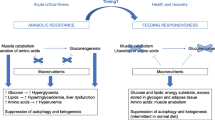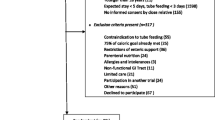Abstract
Objective
To study the effect of a high-protein enteral formula enriched with arginine, glutamine, and antioxidants and containing ω3 fatty acids and a mixture of fibers, on the clinical outcome of a heterogeneous intensive care (ICU) population.
Design and setting
A randomized, prospective, double blind, controlled, two-center clinical trial in two intensive care units in The Netherlands.
Patients and participants
A total of 597 adult ICU patients expected to require enteral tube feeding for more than 2 days were randomized to receive immunonutrition or an isocaloric control formula.
Interventions
Patients received either the immunonutrition or the control feed.
Measurements and results
Intention-to-treat and per-protocol analyses showed no statistically significant difference in clinical outcome parameters between the two groups. Results of the intention-to-treat analysis in control vs. immunonutrition were: median ICU length of stay in days, 8.0 (IQR 5.0–16.0) vs. 7.0 (4.0–14.0); median hospital length of stay in days, 20.0 (IQR 10.0–34.0) vs. 20.0 (10.0–35.0); median days of ventilation, 6.0 (IQR 3.0–12.0) vs. 6.0 (IQR 3.0–12.0); ICU mortality, 26.8% vs. 28.2%; in-hospital mortality, 36.4% vs. 38.5%; infectious complications, 41.7% vs. 43.0%
Conclusions
The results of this largest randomized, controlled trial found that in the general ICU population immunonutrition has no beneficial effect on clinical outcome parameters. These results are consistent with the literature that is currently available.

Similar content being viewed by others

References
Braunschweig CL, Levy P, Sheean PM, Wang X (2001) Enteral compared with parenteral nutrition: a meta-analysis. Am J Clin Nutr 74:534–542
DeWitt RC, Kudsk KA (1998) Enteral nutrition. Gastroenterol Clin North Am 27:371–386
Boelens PG, Nijveldt RJ, Houdijk AP, Meijer S, van Leeuwen PA (2001) Glutamine alimentation in catabolic state. J Nutr 131:2569S-2577S
Calder PC, Yaqoob P, Thies F, Wallace FA, Miles EA (2002) Fatty acids and lymphocyte functions. Br J Nutr 87:S31–S48
Evoy D, Lieberman MD, Fahey TJ 3rd, Daly JM (1998) Immunonutrition: the role of arginine. Nutrition 14:611–617
Grimm H, Mayer K, Mayser P, Eigenbrodt E (2002) Regulatory potential of n-3 fatty acids in immunological and inflammatory processes. Br J Nutr 87 [Suppl 1]:S59–S67
Houdijk A, Rijnsburger E, Jansen J, et al (1998) Randomised trial of glutamine enriched nutrition on infectious morbidity in patients with multiple trauma. Lancet 352:772–726
Newsholme P (2001) Why is L-glutamine metabolism important to cells of the immune system in health, postinjury, surgery or infection? J Nutr 131:2515S-2522S
Alexander JW (2002) Nutritional pharmacology in surgical patients. Am J Surg 183:349–352
Bower RH, Cerra FB, Bershadsky B, Licari JJ, Hoyt DB, Jensen GL, Van Buren CT, Rothkopf MM, Daly JM, Adelsberg BR (1995) Early enteral administration of a formula (Impact) supplemented with arginine, nucleotides, and fish oil in intensive care unit patients: results of a multicenter, prospective, randomized, clinical trial. Crit Care Med 23:436–449
Atkinson S, Sieffert E, Bihari D (1998) A prospective, randomized, double-blind, controlled clinical trial of enteral immunonutrition in the critically ill. Guy’s Hospital Intensive Care Group. Crit Care Med 26:1164–1172
Galban C, Montejo JC, Mesejo A, Marco P, Celaya S, Sanchez-Segura JM, Farre M, Bryg DJ (2000) An immune-enhancing enteral diet reduces mortality rate and episodes of bacteremia in septic intensive care unit patients. Crit Care Med 28:643–648
Dent DL, Heyland D, Levy H, Martindale R, Tayek J, Schloerb P, Kelly MJ (2003) Immunonutrition may increase mortality in critically ill patients with pneumonia: results of a randomized trial. Crit Care Med 30:A17
Bertolini G, Iapichino G, Radrizzani D, Facchini R, Simini B, Bruzzone P, Zanforlin G, Tognoni G (2003) Early enteral immunonutrition in patients with severe sepsis: results of an interim analysis of a randomized multicentre clinical trial. Intensive Care Med 29:834–840
Heyland DK, Novak F, Drover JW, Jain M, Su X, Suchner U (2001) Should immunonutrition become routine in critically ill patients? A systematic review of the evidence. JAMA 286:944–953
Beale RJ, Bryg DJ, Bihari DJ (1999) Immunonutrition in the critically ill: a systematic review of clinical outcome. Crit Care Med 27:2799–2805
Heys SD, Walker LG, Smith I, Eremin O (1999) Enteral nutritional supplementation with key nutrients in patients with critical illness and cancer: a meta-analysis of randomized controlled clinical trials. Ann Surg 229:467–477
Montejo JC, Zarazaga A, Lopez-Martinez J, Urrutia G, Roque M, Blesa AL, Celaya S, Conejero R, Galban C, Garcia de Lorenzo A, Grau T, Mesejo A, Ortiz-Leyba C, Planas M, Ordonez J, Jimenez FJ (2003) Immunonutrition in the intensive care unit. A systematic review and consensus statement. Clin Nutr 22:221–233
Heyland DK, Dhaliwal R, Drover JW, Gramlich L, Dodek P (2003) Canadian clinical practice guidelines for nutrition support in mechanically ventilated, critically ill adult patients. J Parenter Enteral Nutr 27:355–373
Heyland DK, Samis A (2003) Does immunonutrition in patients with sepsis do more harm than good? Intensive Care Med 29:669–671
Kieft H, Roos A, Bindels A, van Drunen J, Hofman Z (2003) Clinical outcome of an immune enhancing diet in a heterogeneous intensive care population. Crit Care Med 31:A82
Roos A, Kieft J, van Drunen J, Bindels J, Hofman Z (2003) Gender differences in clinical outcome of an immune enhancing diet in ICU patients: a hypothesis. Crit Care Med 31:A7
Casati A, Colombo S, Leggieri C, Muttini S, Capocasa T, Gallioli G (1996) Measured versus calculated energy expenditure in pressure support ventilated ICU patients. Minerva Anestesiol 62:165–170
Horan TC, Gaynes RP, Martone WJ (1992) CDC definitions of nosocomial surgical site infections, a modification of CDC definitions of surgical wound infections. Am J Infect Control 20:271–274
Garner JS, Jarvis WR, Emori TG, Horan TC (1988) CDC definitions for nosocomial infections. Am J Infect Control 16:128–140
Veterans Affairs Total Parenteral Nutrition Cooperative Study Group (1991) Perioperative total parenteral nutrition in surgical patients. N Engl J Med 325:525–532
Murray JF, Matthay MA, Luce JM, Flick MR (1988) An expanded definition of the adult respiratory distress syndrome. Am Rev Respir Dis 38:720-723
Colman R, Robboy S, Minna J (1979) Disseminated intravascular coagulation: a reappraisal. Annu Rev Med 30:359–374
Hollis S, Campbell F (1999) What is meant by intention to treat analysis? Survey of published randomised controlled trials. BMJ 319:670–674
Lachin JL (2000) Statistical considerations in the intent-to-treat principle. Control Clin Trials 21:526
Lewis JA, Machin D (1993) Intention to treat—who ishould use ITT? Br. J. Cancer 68:647–650
Lee YJ, Ellenberg JH, Hirtz DG, Nelson KB (1991) Analysis of clinical trials by treatment actually received: is it really an option? Stat Med 10:1595–1605
(2001) Consensus recommendations from the US summitt on immune-enhancing enteral therapy. J Parenter Enteral Nutr 25:S61–S63
McCowen KC, Bistrian BR (2003) Immunonutrition: problematic or problem solving? Am J Clin Nutr 77:764–770
Heyland DK, Novak F (2001) Immunonutrition in the critically ill patient: more harm than good? J Parenter Enteral Nutr 25:S51–S55
Calder PC (2003) Immunonutrition may have beneficial effects in surgical patients. BMJ 327:117–118
Dinkel RH, Lebok U (1994) A survey of nosocomial infections and their influence on hospital mortality rates. J Hosp Infect 28:297–304
Wohltmann CD, Franklin GA, Boaz PW, Luchette FA, Kearney PA, Richardson JD, Spain DA (2001) A multicenter evaluation of whether gender dimorphism affects survival after trauma. Am J Surg 181:297–300
Knudson MM, Lieberman J, Morris JA Jr, Cushing BM, Stubbs HA (1994) Mortality factors in geriatric blunt trauma patients. Arch Surg 129:448–453
Napolitano LM, Greco ME, Rodriguez A, Kufera JA, West RS, Scalea TM (2001) Gender differences in adverse outcomes after blunt trauma. J Trauma 50:274–280
Mostafa G, Huynh T, Sing RF, Miles WS, Norton HJ, Thomason MH (2002) Gender-related outcomes in trauma. J Trauma 53:430–434
Jacobsen SJ, Goldberg J, Miles TP, Brody JA, Stiers W, Rimm AA (1992) Race and sex differences in mortality following fracture of the hip. Am J Public Health 82:1147–1150
Wichmann MW, Inthorn D, Andress HJ, Schildberg FW (2000) Incidence and mortality of severe sepsis in surgical intensive care patients: the influence of patient gender on disease process and outcome. Intensive Care Med 26:167–172
Suchner U, Heyland DK, Peter K (2002) Immune-modulatory actions of arginine in the critically ill. Br J Nutr 87:S121–S132
Merimee TJ, Rabinowtitz D, Fineberg SE (1969) Arginine-initiated release of human growth hormone. Factors modifying the response in normal man. N Engl J Med 280:1434–148
Bereket A, Lang CH, Wilson TA (1999) Alterations in the growth hormone-insulin-like growth factor axis in insulin dependent diabetes mellitus. Horm Metab Res 31:172–181
Takala J, Ruokonen E, Webster NR, Nielsen MS, Zandstra DF, Vundelinckx G, Hinds CJ (1999) Increased mortality associated with growth hormone treatment in critically ill adults. N Engl J Med 341:785–792
Berghe G van den, Wouters P, Weekers F, Verwaest C, Bruyninckx F, Schetz M, Vlasselaers D, Ferdinande P, Lauwers P, Bouillon R (2001) Intensive insulin therapy in the surgical intensive care unit. N Engl J Med 345:1359–1367
Lynch EA, Dinarello CA, Cannon JG (1994) Gender differences in IL-1 alpha, IL-1 beta, and IL-1 receptor antagonist secretion from mononuclear cells and urinary excretion. J Immunol 153:300–306
Pacifici R, Rifas L, McCracken R, Vered I, McMurtry C, Avioli LV, Peck WA (1989) Ovarian steroid treatment blocks a postmenopausal increase in blood monocyte interleukin 1 release. Proc Natl Acad Sci U S A 86:2398–2402
Acknowledgements
The authors thank Marianne van Hengel, Gerdien Melis, and Annette Coenen and all the ICU dieticians, nurses, and secretaries of both participating hospitals. We also thank Prof. R. Westendorp for his statistical consultation. Nutricia N.V. (The Netherlands) kindly provided the study products.
Author information
Authors and Affiliations
Corresponding author
Rights and permissions
About this article
Cite this article
Kieft, H., Roos, A.N., van Drunen, J.D.E. et al. Clinical outcome of immunonutrition in a heterogeneous intensive care population. Intensive Care Med 31, 524–532 (2005). https://doi.org/10.1007/s00134-005-2564-x
Received:
Accepted:
Published:
Issue Date:
DOI: https://doi.org/10.1007/s00134-005-2564-x



